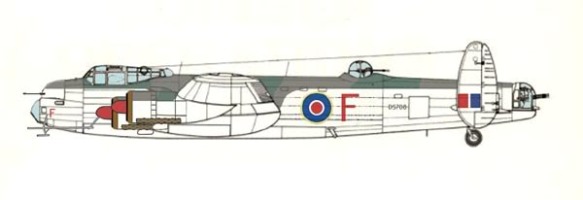Designed as a back up in case Merlin production was interrupted, the 300 Hercules-powered Lancaster Mk.IIs built were dropped by Bomber Command in the interests of commonality in autumn 1944. Because of their better performance at lower altitudes many of them found their way to Coastal Command, operating alongside Liberators in the long range anti-submarine role.
Bulged bomb bay doors and ventral turret were removed to reduce drag and nose-mounted Yagi aerials formed part of the ASV equipment. Front turrets were faired over and provision was made for 4 fixed 20mm cannon in the nose, although only 2 were often carried. Some aircraft had their upper turrets removed to save weight and increase range.
Though the Lancaster is rightly associated in particular with Bomber Command, it was briefly a Coastal Command aircraft too during the war and served in peacetime. It would have added considerably to the ability of the Command to perform a number of its tasks, had it been made available in larger numbers and on a permanent basis. Here was an example of “Cinderella Service” treatment.
In 1940 the Avro Chief Designer Roy Chadwick and his team were working on a four-engine version of the Avro Manchester, two-engine bomber, which would be equipped with Rolls Royce Merlin engines. With the Merlin badly needed for Hurricane and Spitfire fighters, the Air Ministry did not encourage the project at first. Eventually, a request to go ahead with the design was made, with the stipulation that as many Manchester components as possible should be used.
The first flight of a prototype Lancaster took place on January 9 1941. On December 24 1941 No. 44 Squadron, based at Waddington, Lincolnshire, became the first squadron in Bomber Command to receive Lancasters. The earliest Lancaster participation in an operation occurred on March 3 1942 when four of the type from No. 44 Squadron laid mines in the Heligoland Bight between the mouth of the River Elbe and the Heligoland Islands.
Over 7,000 Lancasters were built and fifty-seven Bomber Command squadrons were equipped with them during the Second World War.
Today the Lancaster lives on most prominently in the shape of PA474, the aircraft operated by the Battle of Britain Memorial Flight from Coningsby, in varying guises.
Nearby, at the former Bomber Command airfield at East Kirkby, the Lincolnshire Aviation Heritage Centre offers the chance to taxi in Lancaster NX611, “Just Jane”. There are hopes that this aircraft will fly again.
During the Second World War, Coastal Command made representations to be allocated Lancasters, but it was not until after hostilities had ended that Lancasters were formally added to the Command. During the war itself some Lancasters were loaned to Coastal Command, but the pressure to keep all of these outstanding aircraft focused on the bomber offensive was always very strong. The Lancaster represents one of the key instances where Coastal Command did not reach the top of the list of Air Ministry priorities.
